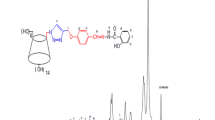Abstract
Circular dichroism (CD) and visible spectra of inclusion compounds between Methyl Orange (MO) analogues and α-, β-, γ-cyclodextrin (cdx), 2,6-dimethyl-and 2,3,6-trimethyl-β-cdx, water soluble α-, β-, γ-cdx polymer products were investigated. In the CD-spectroscopic investigation, the complex with α-cdx epichlorohydrin condensate showed a large amplitude and splitting of the induced π → π* band. Fractions of glyceryl ether of less than 2000 and polymer of more than 10000 dalton molecular mass were separated. Complexes of above two fractions and MO showed the same splitting spectral pattern. Job's plots from visible spectra showed the formation of the 1∶1 complex and CD-data suggested the co-existence of the 2∶1 MO-cdx complex. This splitting pattern showed the reversal of the signs when α-cdx-ethyleneglycol-bis(epoxypropyl) ether was used and disappeared when larger host molecules and azo dyes were used. The splitting was explained by exciton interaction.
Similar content being viewed by others
References
This is Part V. of Cyclodextrin and Azo Dye Series; Part IV (b). M. Suzuki and Y. Sasaki, Chem. Pharm. Bull.,32, 832 (1984).
J. Szejtli, (Ed.): “Proceeding of the Ist International Symposium on Cyclodextrins” Akadémiai Kiadó, Budapest (1982) p. 327, b) p. 345.
J. Szejtli, É. Fenyvesi, É. Dósa, B. Antal, P. Wagner and K. Kállói, Hung. Patent Application 2586 (1981).
A. Harada, M. Furue and S. Nozakura, Polymer J.13, 777 (1981).
M. Suzuki, and Y. Sasaki, Chem. Pharm. Bull., a)27, 1343 (1979). b)27, 609 (1979).
H. Hirai, N. Toshima, and S. Uenoyama, Polym. J.,13, 607 (1981).
M. Hatano, M. Yoneyama, Y. Sato and Y. Kawamura, Biopolymers,12, 2423 (1973).
H. Yamamoto and A. Nakazawa, Bull. Chem. Soc. Jpn.,56, 2535 (1983).
N. Nakashima, H. Fukushima and T. Kunitaka, Chem. Lett., 1207 (1981).
F. Quadrifoglio and V. Crescenzi, J. Colloid Interface Sci.,35, 447 (1971).
J. Fabian, and H. Hartmann: “Light Absorption of Organic Colorants” Springer-Verlag Berlin, Heidelberg, New York (1980), 45.
T. Hoshino, U. Matsumoto, N. Harada and T. Goto Tetrahedron Lett.,22, 3621 (1981).
R.J. Clark, J.H. Coates and S.F. Liceln, Carbohydr. Res.,127, 181 (1984).
V.J.A. Trisnadi, H.M. Bösler and R.C. Schulz, Colloid and Polymer Sci.,252, 222 (1974).
Author information
Authors and Affiliations
Rights and permissions
About this article
Cite this article
Suzuki, M., Fenyvesi, É., Szilasi, M. et al. Spectroscopic investigation of cyclodextrin monomers, derivatives, polymers and azo dyes (1). Journal of Inclusion Phenomena 2, 715–724 (1984). https://doi.org/10.1007/BF00662239
Issue Date:
DOI: https://doi.org/10.1007/BF00662239




